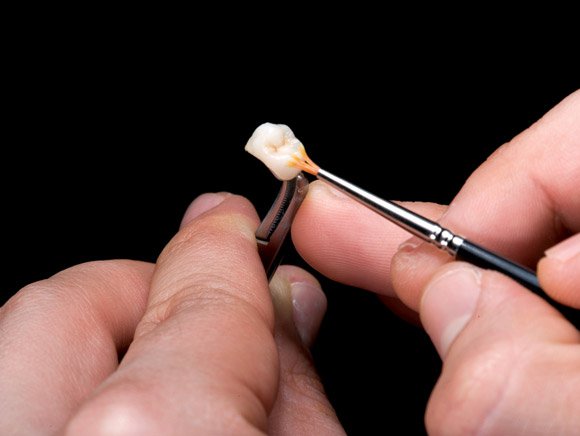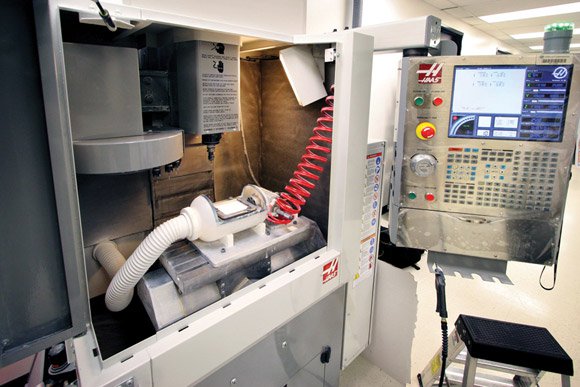Micro-Machining Dental Ceramics
Evidence from India suggests that clever people were drilling, filing and shaping living teeth as early as around 9,000 BCE. Despite this 11,000-year history, modern dentists and laboratory machinists concede that the inside of a human mouth is a particularly poor place to attempt precision work.
Obviously, dentists still fashion cavity fillings and temporary restorative repairs inside their patients’ mouths. But permanent dental restorations, like crowns and bridges (a grouping of three or more connected crowns to bridge-over missing teeth), are now invariably manufactured in specialized dental laboratories. Though “manufactured” is the accepted term within the big labs, it may be a bit misleading. Although they regularly turn out thousands of pieces each day, each one is custom-made.
A recent visit to the largest and perhaps most modern dental restoration company in North America – Glidewell Laboratories of Newport Beach, California – brought to mind a Popular Mechanics article I’d read as a child that recounted opening-day activities at a vocational school for dental lab technicians.
Each new student was given a set of dental picks, a 1-inch cube of wax and an overnight assignment: “Sculpt something interesting for tomorrow’s class.” An aspiring technician shaped a wax ice cube with smoothly rounded corners, and another turned in a small pyramid with his initials neatly inscribed on each side. But one student presented a tiny working Ferris wheel – complete with stabilization bracing, a ticket booth and five self-leveling seats!
The point is that individual talents vary, and since all dental restorations at that time were handcrafted, their individual quality varied, as well. That, of course, was then.

This Is Now
Dental labs still consider their technicians to be artists, even though CAD/CAM systems were introduced into tooth manufacturing more than a decade ago. But new systems for digitally scanning a prepared tooth model and then micro-machining the crown material have changed things dramatically. This fresh approach has expanded productivity and improved the quality of the product. Now, stronger and more aesthetically pleasing materials can be used for dental restorations, with ceramic materials, which now can be machined economically, taking the place of molded and hand-finished malleable metals, like gold or chrome alloys.
Glidewell’s Vice President of Research and Development for Digital Manufacturing Technology, Mervyn Rudgley, is one of those striving to change the way dental crowns and bridges are made. “I don’t view this facility as a laboratory,” he explains, “I view this as a factory.” Since joining Glidewell three years ago, his primary task has been to develop the company’s own branded line of CNC-machined ceramic crowns. After an intensive period of development, Glidewell’s zirconia-based Prismatik CZ crowns are now in full production.

How We Got Here
The traditional starting point for crowns and bridges is a plaster casting that labs create from a mouth impression (mold) supplied by the dentist. A resilient inner sleeve, called the coping, is designed to precisely fit the prepared model tooth. It is investment-cast from chrome-cobalt alloys, or formed by wrapping a metal-impregnated wax sheet directly over the plaster casting. This strong yet flexible coping is then covered with a hard, natural-looking porcelain outer shell. The liquid porcelain is first poured or injected into a wax mold surrounding the coping, and then fired and fused to the metal.
In contrast, a one-piece crown is cast from solid gold using the lost-wax molding process to shape the inner and outer surfaces at the same time. Gold is an excellent biocompatible material, and the “standard” for tooth repair. Gold crowns are often used to restore rear teeth, but are less aesthetically desirable for front teeth. Ceramic restorations that are more natural looking clearly are the trend of the future, and the demand for them is increasing.
Why So Complicated?
If ceramic materials can be molded, why is machining necessary? The answer lies in the incredible power of the human bite. Posterior teeth clamp down with a force of up to 200 lb. If the object of that bite is a small caraway seed (with 0.1 mm2 of contact area), the compression on the teeth can exceed 1-million pounds-per-square-inch!
While standard molded, hand-colored porcelain matches natural tooth enamel very well, it isn’t strong enough in the thin marginal area near the gum line to withstand the force of a strong bite. That’s why metal copings were originally developed – as thin, flexible understructures for the porcelain crowns. Recent man-made ceramics like zirconia are much stronger, and since they’re white, they promise to be a near-perfect material for crown copings. But zirconia is essentially a sintered material that cannot be molded precisely; it must be machined.
If zirconia is already white, why make a sleeve, then cover it with porcelain? Why not simply machine a solid crown from it? The ironic answer is, the material is too white.
“It’s so bright,” says Rudgley, “that anytime you open your mouth, people would think you’d swallowed a flashlight! It’s too opaque, and doesn’t have the natural color variations – the blues and the pinks – of real teeth,” he adds. “Ordinary porcelain, on the other hand, can be artistically colored, and when outer translucent layers are added, it looks incredibly natural.”
So the marriage of a thin but strong zirconia inner sleeve fused to a lifelike porcelain outer structure meets all the requirements: It looks good, has no dark margin to peek above the gum line and it’s strong enough to last. The only problem with the all-ceramic crown, offers Rudgley, is that “It is a bit challenging to machine.”
Cutting Their Teeth
Glidewell Lab’s new open-technology approach to ceramic machining contrasts starkly with existing closed-system solutions available in the industry. Rudgley’s team developed CAD/CAM software interfaces and production techniques that work openly with white-light or laser 3-D scanners and high-speed CNC mills. Although designed specifically to cut zirconia, the open-system elements can be readily adapted to the next generation of ceramics (or other materials), as they become available.
Though some other systems hard-mill zirconia, Glidewell chooses to machine its 0.5 mm thick copings from a less-dense, bisque-fired block, and then sinter the cut pieces at 1500 °C for 12 hours to harden them. The technique eliminates the need for costly diamond cutting tools that are rapidly consumed during hard milling. This is one reason Glidewell can produce all-ceramic crowns for about the same cost as conventional porcelain-fused-to-metal units.
One interesting part of the process is predicting the shrinkage that occurs during sintering. “We aim for a precise seal between the coping margin and the tooth,” says Rudgley. “That means we have to hold a tolerance of 10 to 20 microns throughout the machining and sintering phases. Since the zirconia can shrink up to 30 percent, depending on its geometry, we have to predictably up-scale our CAD design before sending the program to the mill.” Rudgley’s software procedures were developed to do that job precisely. “If the cutter’s good, the material’s perfect and the wind’s blowing just right, we’re going to get a crown that fits perfectly,” he says with a smile.
Haas Automation OM-2A Office Mills are the CNC machines of choice for Glidewell’s open system. A metal-frame fixture mounted to the machine’s table holds a 4″ x 6″ x 3/4″ block of clinical zirconia for machining. Pressurized air flowing across the fixture carries the abrasive machining debris into a 3″ diameter vacuum line that exits through the back of the OM-2A Office Mill, and eventually connects to the lab’s central vacuum system.
Up to 16 individual copings can be machined from each block. Rough cutting is performed with a 3 mm ball endmill, and finish passes are done with a similar 1 mm tool – all at 30,000 rpm. After the top side is cut, the zirconia block is turned over and remounted in the precision fixture for second-op processing. Total cycle time for each coping is about 16 minutes; the entire block of 16 copings runs for about 4 hours.
Machined copings receive minimal handling while in their bisque form. After firing, however, their thin margin edges (200-micron) are hard-machined with a turbine wheel, if required. They are then sent to another area of the lab where the external porcelain “anatomy” is applied.
Reliable Manufacturing
Dental labs have used lightweight CNC specialty mills for low-volume zirconia machining since the late ’90s, but high-volume ceramic machining is quite different. The Haas OM-2A Office Mills that Glidewell uses (in six locations throughout North America) are considerably more powerful, and constructed much more solidly than the lightweight machines. Equipped with 30,000-rpm 20-taper spindles and automatic tool changers, the compact Office Mills are well suited for continuous production.
“In a previous endeavor,” stresses Rudgley, “I learned the importance of good machine reliability, and how closely that’s linked to a good service network. That’s why I ultimately chose Haas machines for this one. We run 24/7 here, producing about 350 ceramic copings per machine per week. We have exactly five days to turn out a crown. Since the porcelain firing takes two, that means we must scan the model, design the nesting and cutting paths, mill both sides and sinter the coping in less than three days!” Extended machine downtime is unthinkable.
“Precision manufacturing is always a challenge,” says Rudgley, “but it’s especially interesting when every part is different. Since there’s no way to individually inspect what we’re making, I calibrate my machines every day,” he adds. “That ten-minute check usually gives us a ‘thumbs up to go,’ but we’re currently working on a probe system that will allow the OM-2A to inspect and, if necessary, adjust itself.”
“All told, we’re doing very well with this system,” Rudgley concludes. “I think our zirconia product is going to continue to grow 10 to 15 percent each month for the foreseeable future. We’re doing nothing that others haven’t done before,” he offers, philosophically. “The big trick is making lots of parts – really small and to quite high precision – and doing it economically. We’ve just managed to do it much more efficiently, and completely openly.”




